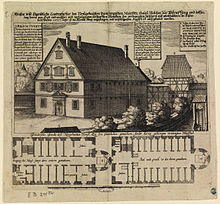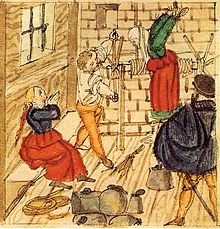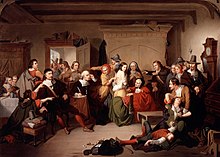A witch-hunt, or a witch purge, is a search for people who have been labeled witches or a search for evidence of witchcraft. The classical period of witch-hunts in Early Modern Europe and Colonial America took place in the Early Modern period or about 1450 to 1750, spanning the upheavals of the Reformation and the Thirty Years' War, resulting in an estimated 35,000 to 50,000 executions.[a][1] The last executions of people convicted as witches in Europe took place in the 18th century. In other regions, like Africa and Asia, contemporary witch-hunts have been reported from sub-Saharan Africa and Papua New Guinea, and official legislation against witchcraft is still found in Saudi Arabia and Cameroon today.
In current language, "witch-hunt" metaphorically means an investigation that is usually conducted with much publicity, supposedly to uncover subversive activity, disloyalty, and so on, but with the real purpose of intimidating political opponents.[2] It can also involve elements of moral panic[3] or mass hysteria.[4]
https://en.wikipedia.org/wiki/Witch-hunt
--------------------------------------------------------------------------------------------------------------------------------
https://mtg.fandom.com/wiki/The_Brothers%27_War/Commander_decks
https://www.starwars.com/databank/nightsisters
https://www.historynet.com/nazi-witches/
https://www.imdb.com/title/tt2381962/
https://www.google.com/url?sa=t&rct=j&q=&esrc=s&source=web&cd=&ved=2ahUKEwj4gdqlmPX-AhXjk4kEHf7pCr04FBAWegQIEBAB&url=https%3A%2F%2Fpreachitteachit.org%2Farticles%2Fdetail%2Fexposing-witchcraft-spiritual-warfare%2F&usg=AOvVaw3yGnfb_qGWTJvejyMMl0AE
--------------------------------------------------------------------------------------------------------------------------------
https://www.legendsofamerica.com/ma-witches-b/
https://www.merriam-webster.com/words-at-play/word-history-witch-hunt
https://www.history.com/news/meet-the-night-witches-the-daring-female-pilots-who-bombed-nazis-by-night
--------------------------------------------------------------------------------------------------------------------------------
https://link.springer.com/chapter/10.1007/978-3-319-56068-7_1
https://www.google.com/url?sa=t&rct=j&q=&esrc=s&source=web&cd=&ved=2ahUKEwiY8tqvmPX-AhVrlIkEHRUHDBU4HhAWegQIDhAB&url=https%3A%2F%2Fwww.routledge.com%2Frsc%2Fdownloads%2FWitchcraft_and_the_Supernatural_FINAL.pdf&usg=AOvVaw2XYhTn6XW66Z5to1EL3lj-
https://www.destinypedia.com/Savath%C3%BBn,_the_Witch_Queen
https://us.macmillan.com/books/9780753459911/salemwitch
--------------------------------------------------------------------------------------------------------------------------------
The Malefizhaus of Bamberg, Germany, where suspected witches were held and interrogated. 1627 engraving.
https://en.wikipedia.org/wiki/Witch-hunt
--------------------------------------------------------------------------------------------------------------------------------
Early Modern Europe and Colonial America
The witch trials in Early Modern Europe came in waves and then subsided. There were trials in the 15th and early 16th centuries, but then the witch scare went into decline, before becoming a major issue again and peaking in the 17th century; particularly during the Thirty Years War. What had previously been a belief that some people possessed supernatural abilities (which were sometimes used to protect the people), now became a sign of a pact between the people with supernatural abilities and the devil. To justify the killings, Protestants, Christians and its proxy secular institutions deemed witchcraft as being associated to wild Satanic ritual parties in which there was naked dancing and cannibalistic infanticide.[54] It was also seen as heresy for going against the first of the ten commandments ("You shall have no other gods before me") or as violating majesty, in this case referring to the divine majesty, not the worldly.[55] Further scripture was also frequently cited, especially the Exodus decree that "thou shalt not suffer a witch to live" (Exodus 22:18), which many supported.
Witch-hunts were seen across early modern Europe, but the most significant area of witch-hunting in modern Europe is often considered to be central and southern Germany.[56] Germany was a late starter in terms of the numbers of trials, compared to other regions of Europe. Witch-hunts first appeared in large numbers in southern France and Switzerland during the 14th and 15th centuries. The peak years of witch-hunts in southwest Germany were from 1561 to 1670.[57] The first major persecution in Europe, when witches were caught, tried, convicted, and burned in the imperial lordship of Wiesensteig in southwestern Germany, is recorded in 1563 in a pamphlet called "True and Horrifying Deeds of 63 Witches".[58] Witchcraft persecution spread to all areas of Europe. Learned European ideas about witchcraft and demonological ideas, strongly influenced the hunt for witches in the North.[59] These witch-hunts were at least partly driven by economic factors since a significant relationship between economic pressure and witch hunting activity can be found for regions such as Bavaria and Scotland.[60]
In Denmark, the burning of witches increased following the reformation of 1536. Christian IV of Denmark, in particular, encouraged this practice, and hundreds of people were convicted of witchcraft and burnt. In the district of Finnmark, northern Norway, severe witchcraft trials took place during the period 1600–1692.[61] A memorial of international format, Steilneset Memorial, has been built to commemorate the victims of the Finnmark witchcraft trials.[62] In England, the Witchcraft Act of 1542 regulated the penalties for witchcraft. In the North Berwick witch trials in Scotland, over 70 people were accused of witchcraft on account of bad weather when James VI of Scotland, who shared the Danish king's interest in witch trials, sailed to Denmark in 1590 to meet his betrothed Anne of Denmark. According to a widely circulated pamphlet, "Newes from Scotland," James VI personally presided over the torture and execution of Doctor Fian.[63] Indeed, James published a witch-hunting manual, Daemonologie, which contains the famous dictum: "Experience daily proves how loath they are to confess without torture." Later, the Pendle witch trials of 1612 joined the ranks of the most famous witch trials in English history.[64]
In England, witch-hunting would reach its apex in 1644 to 1647 due to the efforts of Puritan Matthew Hopkins. Although operating without an official Parliament commission, Hopkins (calling himself Witchfinder General) and his accomplices charged hefty fees to towns during the English Civil War. Hopkins' witch-hunting spree was brief but significant: 300 convictions and deaths are attributed to his work.[65][failed verification] Hopkins wrote a book on his methods, describing his fortuitous beginnings as a witch-hunter, the methods used to extract confessions, and the tests he employed to test the accused: stripping them naked to find the Witches' mark, the "swimming" test, and pricking the skin. The swimming test, which included throwing a witch, who was strapped to a chair, into a bucket of water to see if she floated, was discontinued in 1645 due to a legal challenge. The 1647 book, The Discovery of Witches, soon became an influential legal text. The book was used in the American colonies as early as May 1647, when Margaret Jones was executed for witchcraft in Massachusetts,[66] the first of 17 people executed for witchcraft in the Colonies from 1647 to 1663.[67]
Witch-hunts began to occur in North America while Hopkins was hunting witches in England. In 1645, forty-six years before the notorious Salem witch trials, Springfield, Massachusetts experienced America's first accusations of witchcraft when husband and wife Hugh and Mary Parsons accused each other of witchcraft. In America's first witch trial, Hugh was found innocent, while Mary was acquitted of witchcraft but she was still sentenced to be hanged as punishment for the death of her child. She died in prison.[68] About eighty people throughout England's Massachusetts Bay Colony were accused of practicing witchcraft; thirteen women and two men were executed in a witch-hunt that occurred throughout New England and lasted from 1645 to 1663.[67] The Salem witch trials followed in 1692–1693.
Once a case was brought to trial, the prosecutors hunted for accomplices. The use of magic was considered wrong, not because it failed, but because it worked effectively for the wrong reasons. Witchcraft was a normal part of everyday life. Witches were often called for, along with religious ministers, to help the ill or deliver a baby. They held positions of spiritual power in their communities. When something went wrong, no one questioned either the ministers or the power of the witchcraft. Instead, they questioned whether the witch intended to inflict harm or not.[69]
Current scholarly estimates of the number of people who were executed for witchcraft vary from about 35,000 to 50,000.[a] The total number of witch trials in Europe which are known to have ended in executions is around 12,000.[70] Prominent contemporaneous critics of witch-hunts included Gianfrancesco Ponzinibio (fl. 1520), Johannes Wier (1515–1588), Reginald Scot (1538–1599), Cornelius Loos (1546–1595), Anton Praetorius (1560–1613), Alonso Salazar y Frías (1564–1636), Friedrich Spee (1591–1635), and Balthasar Bekker (1634–1698).[71] Among the largest and most notable of these trials were the Trier witch trials (1581–1593), the Fulda witch trials (1603–1606), the Würzburg witch trial (1626–1631) and the Bamberg witch trials (1626–1631).[citation needed]
In addition to known witch trials, witch hunts were often conducted by vigilantes, who may or may not have executed their victims. In Scotland, for example, cattle murrains were blamed on witches, usually peasant women, who were duly punished. A popular method called "scoring above the breath" meant slashing across a woman's forehead in order to remove the power of her magic. This was seen as a kind of emergency procedure which could be performed in absence of judicial authorities.[72]
https://en.wikipedia.org/wiki/Witch-hunt
https://en.wikipedia.org/wiki/Black_magic



No comments:
Post a Comment